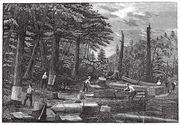Difference between revisions of "Hemlock bark"
m (Text replace - "== Authority ==" to "== Sources Checked for Data in Record ==") |
|||
| (4 intermediate revisions by the same user not shown) | |||
| Line 1: | Line 1: | ||
| + | [[File:HemlocktreesPratt.jpg|thumb|Stripping Hemlock trees for tanning. Credit: Zadock Pratt Museum.]] | ||
| + | [[File:Prattpark.jpg|thumb|Portion of Pratt Rock showing a horse and hemlock tree. Credit: Pratt Rock Museum]] | ||
== Description == | == Description == | ||
| Line 7: | Line 9: | ||
eastern hemlock (''Tsuga canadensis''); western hemlock (''Tsuga heterophylla''); spruce bark; huid van een Canadese den (Ned); | eastern hemlock (''Tsuga canadensis''); western hemlock (''Tsuga heterophylla''); spruce bark; huid van een Canadese den (Ned); | ||
| − | == | + | == Resources and Citations == |
| − | + | * Zadock Pratt Museum: https://zadockprattmuseum.org (accessed April 2020) | |
| − | |||
| − | |||
* R.J. Adrosko, ''Natural Dyes in the United States'', Smithsonian Institution Press, Washington, DC, 1968 | * R.J. Adrosko, ''Natural Dyes in the United States'', Smithsonian Institution Press, Washington, DC, 1968 | ||
| Line 21: | Line 21: | ||
* F. Crace-Calvert, ''Dyeing and Calico Printing'', Palmer & Howe, London, 1876 | * F. Crace-Calvert, ''Dyeing and Calico Printing'', Palmer & Howe, London, 1876 | ||
| − | * ''Encyclopedia Britannica'', http://www.britannica.com Comment: "Hemlock." | + | * ''Encyclopedia Britannica'', http://www.britannica.com Comment: "Hemlock." Accessed: 18 Aug. 2004 . |
[[Category:Materials database]] | [[Category:Materials database]] | ||
Latest revision as of 09:58, 19 August 2020
Description
The bark extract from the Eastern hemlock, Tsuga canadensis, and Western hemlock, Tsuga heterophylla, contains up to 22% tannins. The extract, however, contains very little sugar for fermentation so organic acids generally need to be added to the tanning bath. Hemlock bark was an important vegetable tanning material in North America for many years producing the characteristic red leather of 19th century America (Roberts and Etherington 1982). The extract was also used as a dye to produce colors ranging from a pinkish tan to a dark gray. Native Americans used hemlock to dye basketry and blankets. Hemlock dye has fair lightfastness and good washfastness.
Synonyms and Related Terms
eastern hemlock (Tsuga canadensis); western hemlock (Tsuga heterophylla); spruce bark; huid van een Canadese den (Ned);
Resources and Citations
- Zadock Pratt Museum: https://zadockprattmuseum.org (accessed April 2020)
- R.J. Adrosko, Natural Dyes in the United States, Smithsonian Institution Press, Washington, DC, 1968
- Palmy Weigle, Ancient Dyes for Modern Weavers, Watson-Guptill Publications, New York, 1974
- Matt Roberts, Don Etherington, Bookbinding and the Conservation of Books: a Dictionary of Descriptive Terminology, U.S. Government Printing Office, Washington DC, 1982
- F. Crace-Calvert, Dyeing and Calico Printing, Palmer & Howe, London, 1876
- Encyclopedia Britannica, http://www.britannica.com Comment: "Hemlock." Accessed: 18 Aug. 2004 .

